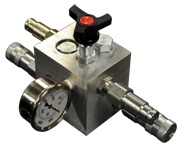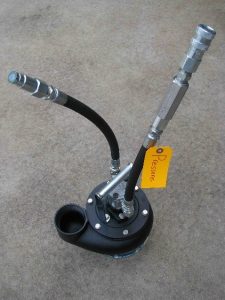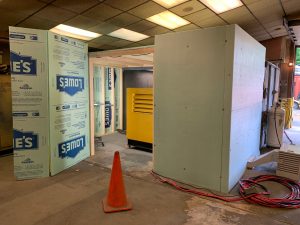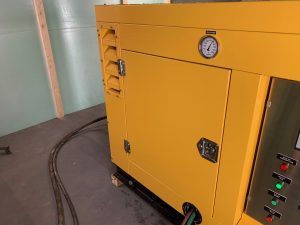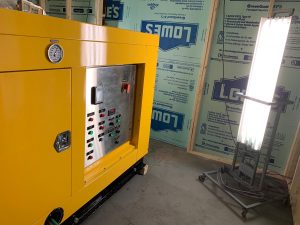https://conta.cc/30biTGr
https://conta.cc/30biTGr
One of the things Hydra-Tech Pumps is known for is our customization – at our website and in our catalog are two long lists of options that are available for both hydraulic submersible dewatering pumps and hydraulic power units, from custom paint to custom design. As we have done before, we wanted to highlight another pair of customer designs.
A brand new prospect contacted us on April 23rd. He works in a pretty serious machine shop down south and was looking for an electric HPU to replace an existing (you might say antique) unit that was supporting a broaching machine. With some pictures of the existing unit in hand we had two maybe three phone calls to nail down the details and provided a quote to this prospect on 4/29, and after some additional changes, a revised quote on 5/1. An order was placed on 5/6 and after the 3-4 weeks to get some of the materials in including the JIC reservoir upon which the unit would be built, we designed, built and tested a one off, multi circuit, custom electric hydraulic power unit in 5 weeks. We would have turned it around in about half that time if not for a recalled electric motor that needed replaced by a supplier.
Speaking of completely custom, we were challenged by a valued, longtime customer to develop a brand new design based off of their very specific needs. In general terms we designed and built a 50 horsepower electric hydraulic power unit in a sound attenuated enclosure that will be used on ships all over the world performing salvage operations.
The customer asked us to perform some pretty significant heat testing. So once the unit was built and ready plans were made and a date for the test was set. On Wednesday July 8th, with personnel from both companies on hand at Hydra-Tech Pumps’ facility, we got started early in the morning with the testing. As the temperature out on the blacktop climbed up to close to 100 degrees we ran the unit for 3 hours under load and monitored oil and motor temperatures and performance.
In case this wasn’t enough, an ever tougher heat test was required by the customer. This unit could potentially be sitting on the deck of a ship at the equator with an ambient temperature of 115 – 120 degrees. To allow us to create this environment for the test, we had to build a temporary structure inside of our building that would allow us to place the unit inside and with the help of some heat lamps and a propane area heater, bring the temperature up to 120 degrees Fahrenheit and maintain that temperature for the duration of the test.
The power unit sat in the enclosure with the ambient temperature being monitored. The hydraulic hoses ran outside through a small hole in the wall of the enclosure, out a door and to a pump that was actually moving water against a simulated head in our outdoor test tank. This allowed the power unit to work as hard as it would in a real world scenario to really test the ability of the hydraulic oil cooler. Three hours later and with both tests successfully completed, the customer left our facility confident that the unit we built would be able to survive a worst case temperature scenario and continue to perform while the salvage divers in the water who rely on its hydraulic power could continue to operate their equipment.
At Hydra-Tech Pumps we are not afraid to go above and beyond for our customers. In some cases, that means a lot of time effort and work going into a one off unit that will likely never be built again. In other cases it means that we come up with a completely new design for a loyal customer that will perform under pressure. New designs always bring about a unique set of challenges. New designs aren’t easy – they tend to present new problems in the testing stages. But we see them through to the finish and deliver a system that satisfies a customer’s needs, even if it’s the only one we’ll ever build. Do you have a custom hydraulic power unit design need that no one else will consider? Give us a call and let’s see if we can do it – I bet we can!
https://conta.cc/2ZcJQry
https://conta.cc/2ZcJQry
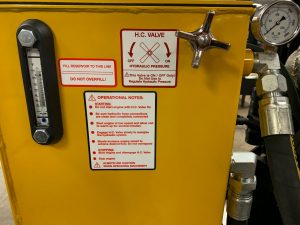 Mounted on the side of the hydraulic oil reservoir on any standard Hydra-Tech Pumps Hydraulic Power Unit is the H.C. (or Hydraulic Control) Valve. The only exception to this is sound attenuated units. Since access to the hydraulic oil reservoir is limited, sound attenuated units do NOT have a H.C. valve. Think of this valve as an “on / off” switch for the hydraulic circuit on your HPU. Once an HPU has been started and warmed up and you are ready to send hydraulic fluid to a pump (or hydraulic tool) properly connected with hydraulic hoses, or deadhead the unit (troubleshooting), this valve should be turned all the way clockwise until the handle stops to engage the hydraulic flow. When you are ready to shut the system down, the H.C. valve should be turned all the way counterclockwise until the handle stops to shut off the hydraulic flow. This valve should not be used to attempt to control flow as doing so will generate heat and cause other problems. If you need to control flow or pressure, Hydra-Tech Pumps offers flow and pressure controls for their pumps and an adjustable inline flow control device as well.
Mounted on the side of the hydraulic oil reservoir on any standard Hydra-Tech Pumps Hydraulic Power Unit is the H.C. (or Hydraulic Control) Valve. The only exception to this is sound attenuated units. Since access to the hydraulic oil reservoir is limited, sound attenuated units do NOT have a H.C. valve. Think of this valve as an “on / off” switch for the hydraulic circuit on your HPU. Once an HPU has been started and warmed up and you are ready to send hydraulic fluid to a pump (or hydraulic tool) properly connected with hydraulic hoses, or deadhead the unit (troubleshooting), this valve should be turned all the way clockwise until the handle stops to engage the hydraulic flow. When you are ready to shut the system down, the H.C. valve should be turned all the way counterclockwise until the handle stops to shut off the hydraulic flow. This valve should not be used to attempt to control flow as doing so will generate heat and cause other problems. If you need to control flow or pressure, Hydra-Tech Pumps offers flow and pressure controls for their pumps and an adjustable inline flow control device as well.
